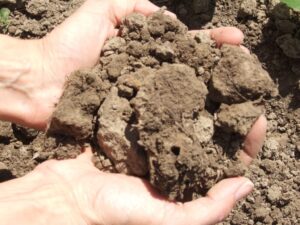
Humic Mine Personalities by NMS
Let’s start in the south and work our way north. Terlingua, TX has a vein that would be the southern end of the New Mexico
I say, “the hardest thing on American soil is concrete.” When tillable soils are “developed” with residential or industrial buildings, streets and supporting systems, we are burying food producing areas. These areas are never restored to the same potential of grain or vegetable crops. Will we wait until hunger ensues before legislations slow the developments?
Regulations on runoff and water quality through the soil are affecting cost of production while the efforts are becoming mutual through cost sharing. Carbon credits through management practices are a great way to offset the efforts. Teams of experienced farmers and credit advocates are eager to help you.
Aeration with a SOIL CURSEBUSTER is becoming my favorite tool for plow layer correction. The epiphany the Creator provided – “aerobic microbes need air”. The deeper we get air, the deeper we improve exudates through root growth to further feed microbes into the water table and deeper nutrients.
Nutrient availability is a function of plant energy, chemistry, and supporting microbes. Balance the chemistry and the soil ph becomes balanced. For soils low on microbes – create the right environment or apply bugs in a jug or a dynamic fertilizer from the fish or animal sector.
Ideal soil type could be under your feet, but it often takes time, labor and focused management. Here are basic goals:
Next is to give our consumers all they want and in comes the term Organics. Organic Agriculture is on the radar also.
Soil Samples taken at 6″ depths and processed at a lab get reported with the content or percentage of minerals available in the root zone. Some labs test soil health – an indication of microbe activity.
The plant’s ability to access and use the minerals is ultimately necessary. Soil and plant ability to absorb, integrate, or benefit from the application can depend on the form the mineral is applied and the soil health (microbial activity) to process the elements.
In Ag we use a term- The 4R’s: Right product, Right amount, Right place, Right time. (ref: various sources – my first solid education came from Conklin: ProAg I and ProAg II- invitation only -contact me)
Planning applications with the 4R’s in mind is a huge step in making efficient use of the product, amending for deficiencies, and setting the stage for success.
The 5th R: Right method (source unknown) Granulated products for example, need dissolved most commonly with moisture, and still have to find its way to the plant to be beneficial for yield or desired outcome. Its application and release timing is important to fit the plant or soil needs. Chelation (of various forms) is a term used for holding a mineral in a package, particularly for adding to a tank mix solution to limit its interaction or loss to the atmosphere.
The 6th R: Right on target (did I make that up?): Mechanical technology or methodology can influence the application uniformity and placement – for example: Strip till vs broadcast, Aerial compared to ground rig, Over top or under cover spraying, Nozzle type and pressure with drift control. My favorite on-target product by way of a surfactant is X-celerate.
R there more? (having fun now): the Right advisor, the Right advice, the Right understanding, the Right operator. R u with me? Sometimes we have all the Right tools, but we could use help or need to invent a solution. Contact me.

Let’s start in the south and work our way north. Terlingua, TX has a vein that would be the southern end of the New Mexico